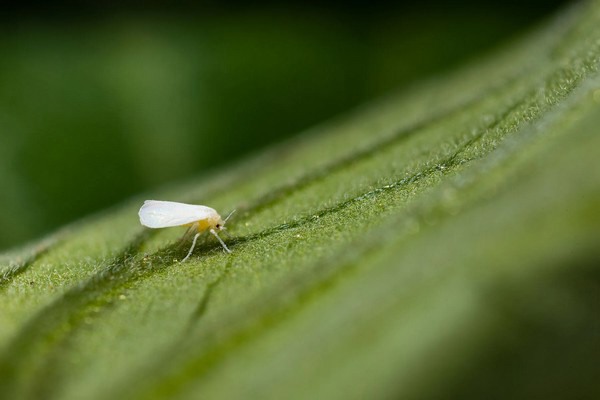Whiteflies are moth-like insects belonging to the family Aleyrodidae. Whiteflies are not true flies but belong to the order Hemiptera (true bugs). Together with aphids and scale insects, they belong to the division Sternorrhyncha. In protected crops, the most common species are the greenhouse whitefly, Trialeurodes vaporariorum, and the tobacco whitefly, Bemisia tabaci. In outdoor crops whiteflies cause significant damage, variety of crops such as tomato, cabbage, potato and citrus.
Life Cycle
Adult females live up to six weeks, and can produce up to 200 eggs, usually laying them on new plant growth on the undersides of leaves. Whiteflies undergo six distinct developmental stages: egg, first, second, third, and fourth larval instars, and finally, the adult stage. The late fourth larval stage is often called a 'pupa.' The eggs are laid upright, spindle-shaped, and attached to a short pedicel. Upon hatching, the young larvae, known as 'crawlers,' have well-developed legs and antennae and actively seek a suitable spot on the leaf to feed.
Once they find a feeding spot, they remain there for the rest of their larval development. The fourth larval instar, when the red eyes of the adult whitefly become visible, is also referred to as a 'pupa.' Whitefly species are most easily distinguished at the pupal stage. The adult whitefly emerges from the hardened cuticle of the pupa through a characteristic T-shaped opening created by splitting along pre-existing seams on the upper surface. Newly emerged adults have two pairs of transparent wings, which later become covered with a white, waxy powder, giving the insect its characteristic appearance. Adult whiteflies typically reside on the underside of young leaves where they lay their eggs.

Preferences
The greenhouse whitefly and tobacco whitefly can thrive on a wide range of different host plants from all manner of families. Whitefly can appear on various vegetable crops, including tomato, cucumber, aubergine, courgette, bean, and pepper as well as potato. A whole host of ornamental crops, including rose, gerbera, hibiscus, and poinsettia, are also not safe from whitefly.
The problem inside the greenhouse is more acute than outside, as temperatures inside tend to be higher. This stimulates the development of the infestation. In addition, rain and wind are factors that affect outdoor areas, lowering the risk of infestation.
The spread of whitefly
Depending on the species, whitefly development of the whitefly population is optimal at temperatures between 20 and 30°C. Flying adult insects spread the infestation, but attacks from outside the greenhouse are also a threat.
The greenhouse whitefly tends to spread over the plant vertically, considering that the larvae can only move in the first stage. The adult insects prefer to lay their eggs on young leaves of the plant, and this is where you tend to find the eggs and young larvae of greenhouse whitefly.
If the population on the infected plant grows too large, the adult insects will fly to another plant in search of somewhere to lay their eggs. An attack from outside the greenhouse also poses a threat of spread.
Spread over the plant
In contrast to the greenhouse whitefly, which prefers to reside inside the plant, the tobacco whitefly spreads out over the plant in its entirety. The females lay their eggs on the underside of the leaves, just the same. Adult insects can spread by flying or simply on the wind.
While the greenhouse whitefly prefers temperatures to be on the more moderate side, the tobacco whitefly is in its element in higher temperatures. An adult female is capable of surviving for ten to fifteen days at temperatures around 30°C. At the same time, an infestation can also live in and survive cold/ winter conditions, even in an empty greenhouse devoid of host plants. However, the tobacco whitefly cannot survive temperatures below freezing.
Damage and Economic Consequence
Whitefly pose a significant threat to a variety of indoor and outdoor crops including annuals, perennials, herbs, and vegetable bedding plants. Found predominantly on the underside of plant leaves, both nymphs and adults have piercing-sucking mouthparts, enabling them to extract plant fluids. The appetite of whitefly larvae for plant sap results in the excretion of excess sugars as honeydew. This honeydew excretion brings about several consequences listed below:
- Detracting from the visual appeal of crops, particularly ornamentals.
- The honeydew deposits on fruit attract dirt and promote the growth of sooty moulds (Cladosporium spp.), rendering affected fruit unsalable and susceptible to rot.
Whitefly also serve as vectors for transmitting viruses between plants, posing additional risks to agricultural and horticultural crops. The greenhouse whitefly can transmit more than 25 viruses with 'Tomato Yellow Leaf Curl Virus' (TYLCV) as one of the most serious.
The larvae of the Tobacco Whitefly inject enzymes into the plant, causing damage. This can include irregular ripening in tomatoes and peppers, yellowing of flower stems in gerbera, and serious yellowing of the leaves in green beans
Extensive feeding can retard plant growth and cause leaves to wilt and drop. This significantly impacts fruit development and yield.
The importance of strategic integrated pest management (IPM)
Whitefly pose significant challenges to greenhouse cultivation, but with an integrated approach to pest management (IPM), their impact can be minimized sustainably. A holistic approach not only helps to mitigate the development of resistance in whitefly populations but also promotes a healthier and more sustainable growing environment. Additionally, IPM strategies consider factors such as crop tolerance, pest thresholds, and environmental conditions, allowing for precise and efficient management tailored to the specific needs of each greenhouse operation. Regular monitoring, early detection, and proactive management are key to success in managing Whiteflies
For more information:
Koppert
info@koppert.com
www.koppert.com
